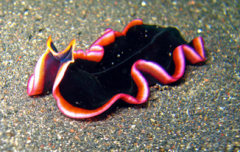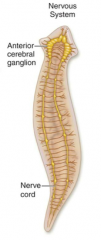![]()
![]()
![]()
Use LEFT and RIGHT arrow keys to navigate between flashcards;
Use UP and DOWN arrow keys to flip the card;
H to show hint;
A reads text to speech;
22 Cards in this Set
- Front
- Back

Classify this. |
Phylum Platyhelminthes, Class Turbellaria, Marine Worm |
|
|
What type of Symmetry does Phylum Platyhelminthes have? |
All classes have bilateral symmetry. |
|
|
How many layers of tissue does Phylum Platyhelminthes have? |
All classes have 3 layers of tissue. |
|
|
Are the classes of Phylum Platyhelminthes ceolomate or aceolomate? |
All classes are aceolomate. |
|
|
How many digestive openings does Phylum Platyhelminthes have? |
All classes have a gastrovascular system, or 1 opening. |
|
|
Do any of the classes in Phylum Platyhelminthes have a circulatory system? |
No all classes do not have this. |
|
|
What is the habitat for all of the classes in Phylum Platyhelminthes? |
All classes are aquatic. |
|
|
Do any of the classes in Phylum Platyhelminthes have respiratory organs? |
No all classes do not have this. |
|
|
In class Turbellaria, what type of excretory system is present? |
Flame cells. |
|
|
In class Trematoda what type of excretory system is present? |
It is reduced or absent |
|
|
In class Cestoda, what type of excretory system is present? |
It is reduced or absent. |
|
|
What type of locomotion is seen in class Turbellaria? |
They are free living. |
|
|
What type of locomotion or life style (hint hint) is present in classes Cestoda and Trematoda? |
They are parasitic. |
|
|
What type of support system is present in classes of Phylum Platyhelminthes? |
All classes have a hydrostatic skeleton. |
|
|
Are classes in Phylum Platyhelminthes segmented? |
No, EXCEPT for Class Cestoda. They have a scolex. |
|
|
Do classes of Phylum Platyhelminthes have a nervous system? |

Yes, they have a nerve ladder/cord. |
|
|
What are the reproductive strategies associated with Class Turbellaria? |
They are hermaphroditic. |
|
|
What are the reproductive strategies associated with Class Trematoda? |
They have sexual and asexual reproduction. |
|
|
What are the reproductive strategies associated with Class Cestoda? |
They are asexual and can reproduce through proglottids or budding. |
|
|
What is an important physical characteristic of Class Turbellaria? |
They have eye spots and all 3 types of muscles. |
|

Classify this. |
Phylum Platyhelminthes, Class Trematoda, Fluke |
|

Classify this. |
Phylum Platyhelminthes, Class Cestoda, Tapeworm. |

